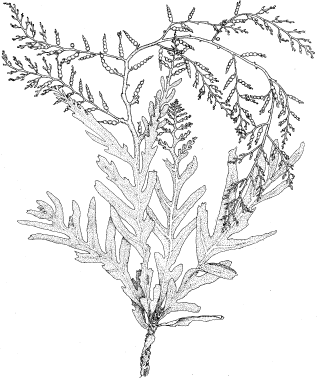Stephanocystis osmundacea
(Turner) TrevisanKey Characteristics
- The largest species in the genus in California
- Stipe triangular in cross-section, with flattened blades with midrib 1-2 divided into pinnae
- Upper portions open and loose, with elliptical floats in series of 5-12
Image Gallery (click for more)
Database links
- Blue markers: specimen records
- Yellow marker: type locality, if present
- Red markers: endpoints of range from literature
View map from the Consortium of Pacific Northwest Herbaria
Notes: Sunset Bay, Oregon to Crescent City, Del Norte Co., then spotty distribution from Humboldt Co. to Sonoma Co. More common from Sonoma Co. to San Diego Co. and through Baja California Sur, including California Channel Islands, except San Clemente Island.
Status: Specimens from throughout California and from Baja California, Mexico were analyzed with ITS, LSU and rbcL as part of an inquiry into species boundaries of Cystoseira (now Stephanocystis), focusing on the North Pacific (Harvey & Goff 2006). There were two clades in the genus, Pacific and Atlantic; species in the the Pacific clade were transferred to Stephanocystis, leaving the Atlantic species in Cystoseira, a polyphyletic genus.
Habitat: Lowest subtidal or more often shallow subtidal, forming a canopy, sometimes mixed with Macrocystis pyrifera.
Life History: Diplontic, with gametic meiosis; dioecious

Illustration from DeCew's Guide to the Seaweeds of British Columbia, Washington, Oregon, and Northern California

Cystoseira C. Agardh 1820
Thalli perennial, differentiated into holdfast, stipe, and branches. Lower thallus persisting (in protected areas) and renewing upper thallus, this of distinctly different morphology. Stipe erect, woody, angled where lateral branches have dropped away, triangular in cross section. Branches radially arranged; lower branches flattened throughout and with slight midrib; upper branches with occasional flattened regions but mainly cylindrical, bearing small pneumatocysts along length, either singly or in catenate series. Gametangia unilocular, developed within conceptacles on receptacles at apices of ultimate branchlets. Plants monoecious or dioecious. Oogonium containing 1 uninucleate egg and 7 residual nuclei, these expelled from cytoplasm before oogonial discharge. Oogonia in C. osmundacea produced successively. Antheridium containing 64 biflagellate sperm.
Cystoseira osmundacea (Turn.) C. Ag.
Fucus osmundaceus Turner 1809: 91. Cystoseira osmundacea (Turn.) C. Agardh 1820: 69; Gardner 1913: 333; Smith 1944: 156 (incl. synonymy).
Thalli to 8 m tall, blackish-brown below, light tan above; primary branches flattened in lower portion, about 1-1.5 cm broad, usually once pinnate (north of Pt. Conception) or bipinnate (south of Pt. Conception); ultimate branches of upper portion with tapering, catenate series of 5-12 subspherical to ellipsoid pneumatocysts; receptacles branched, flattened or terete, developing from branchlets distal to pneumatocysts; plant dioecious.
Occasional on rocks in lower intertidal, common subtidally (to 10 m), frequently mingled with Macrocystis beds along Monterey Peninsula; Seaside, Ore., to Ensenada, Baja Calif. Type locality: Trinidad (Humboldt Co.), Calif.
C. osmundacea intergrades gradually with the other two species in Calif., and intermediates should be expected. Nonetheless, it seems worthwhile to retain the species C. neglecta and C. setchellii on the grounds that they represent morphological types characteristic of certain environments.
Excerpt from Abbott, I. A., & Hollenberg, G. J. (1976). Marine algae of California. Stanford University Press, Stanford, California. xii [xiii] + 827 pp., 701 figs.
Notes: Now (back to) Stephanocystis; Cystoseira is a European genus (Harvey & Goff 2006; Draisma et al. 2010). S. neglecta and S. setchellii are good species (Harvey & Goff 2006).
NATIVE
Vertical Distribution: Lowest intertidal - shallow subtidal
Frequency: Frequent, locally common
Substrate: Rock
Type locality: Trinidad, Humboldt Co., California
